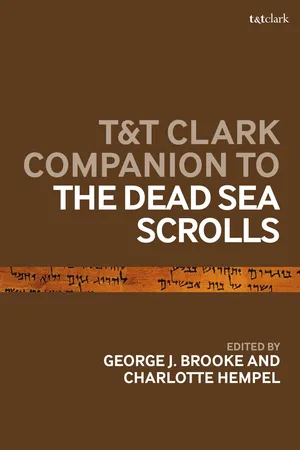
T&T Clark Companion to the Dead Sea Scrolls
- 672 pages
- English
- ePUB (mobile friendly)
- Available on iOS & Android
T&T Clark Companion to the Dead Sea Scrolls
About This Book
The Dead Sea Scrolls are one of the most important archaeological discoveries of the last century. They have great historical, religious, and linguistic significance, not least in relation to the transmission of many of the books which came to be included in the Hebrew Bible. This companion comprises over 70 articles, exploring the entire body of the key texts and documents labelled as Dead Sea Scrolls. Beginning with a section on the complex methods used in discovering, archiving and analysing the Scrolls, the focus moves to consideration of the Scrolls in their various contexts: political, religious, cultural, economic and historical. The genres ascribed to groups of texts within the Scrolls- including exegesis and interpretation, poetry and hymns, and liturgical texts - are then examined, with due attention given to both past and present scholarship. The main body of the Companion concludes with crucial issues and topics discussed by leading scholars. Complemented by extensive appendices and indexes, this Companion provides the ideal resource for those seriously engaging with the Dead Sea Scrolls.
Frequently asked questions
Information
Part One
Background
1
Discoveries
A Handful of Manuscripts from a Deserted Cave
An Eventful Week and Its Long-Lasting Consequences
Table of contents
- Cover
- Half-Title Page
- Dedication
- Title Page
- Contents
- List of Illustrations
- Notes on Contributors
- Abbreviations
- Introduction
- Part I Background
- 1 Discoveries
- 2 Archaeology of Qumran
- 3 The Manuscript Collections: An Overview
- 4 Acquisition and Publication
- 5 Scholarly and Popular Reception
- Part II Context
- 6 Ethnicity: A Fresh Religious Context for the Scrolls
- 7 The Yahad in the Context of Hellenistic Group Formation
- 8 The Regional Context of the Dead Sea
- 9 Qumran and the Ancient Near East
- 10 Scrolls and Early Judaism
- 11 Scrolls and Early Christianity
- 12 Scrolls and Hellenistic Jewish Literature:
- 13 Scrolls and Non-Jewish Hellenistic Literature
- Part III Methods
- 14 Physicality of Manuscripts and Material Culture
- 15 Scientific Technologies
- 16 Reading and Reconstructing Manuscripts
- 17 Languages: Hebrew, Aramaic, Greek
- 18 Biblical Scholarship and Qumran Studies
- 19 The Dead Sea Scrolls and the Study of the Ancient World
- 20 Historiography
- 21 Social Scientific Approaches:
- 22 Postmodern Questions and Sexuality Studies
- Part IV Key Texts
- 23 Aramaic Job David Shepherd
- 24 Aramaic Levi Vered Hillel
- 25 Authoritative Scriptures: Torah and Related Texts Katell Berthelot
- 26 Authoritative Scriptures: Prophets and Related Texts Roman Vielhauer
- 27 Authoritative Scriptures: Writings and Related Texts Ulrich Dahmen
- 28 Authoritative Scriptures: Other Texts Kelley Coblentz Bautch and Jack Weinbender
- 29 Barkhi Nafshi Daniel K. Falk
- 30 Bar Kokhba Letters Lutz Doering
- 31 Beatitudes Dorothy M. Peters
- 32 Berakhot Daniel K. Falk
- 33 Commentaries on Genesis (4Q252–254) George J. Brooke
- 34 Copper Scroll Jesper Høgenhaven
- 35 Damascus Document (D) Liora Goldman
- 36 Genesis Apocryphon Daniel A. Machiela
- 37 Hodayot (H) Angela Kim Harkins
- 38 Instruction Benjamin Wold
- 39 Messianic Apocalypse Eric F. Mason
- 40 Milh. amah (M) Brian Schultz
- 41 Miqṣat Maʿaśeh ha-Torah (MMT) Hanne von Weissenberg
- 42 Mysteries Samuel I. Thomas
- 43 New Jerusalem Michael Langlois
- 44 Pesharim Shani Tzoref
- 45 Rule of Blessings (Sb) Judith H. Newman
- 46 Rule of the Congregation (Sa) Corrado Martone
- 47 Serekh ha-Yahad (S) Stephen Hultgren
- 48 Songs of the Sabbath Sacrifice Judith H. Newman
- 49 Son of God Text
- 50 Tanḥumim
- 51 Temple Scroll
- 52 Testimonia
- 53 Wiles of the Wicked Woman
- 54 Words of the Luminaries
- Part V Types of Literature
- 55 Bible
- 56 Parabiblical Texts/Rewritten Scripture
- 57 Exegesis and Interpretation
- 58 Halakhah
- 59 Rules
- 60 Poetry and Hymns
- 61 Liturgical Texts
- 62 Calendars
- 63 Wisdom
- 64 Mystical Texts, Magic, and Divination
- Part VI Issues and Topics
- 65 Patriarchs and Aramaic Traditions
- 66 Revelation
- 67 God(s), Angels and Demons
- 68 Eschatologies and Messianisms
- 69 Jerusalem and the Temple
- 70 Purity and Holiness
- 71 The Scribes of the Scrolls
- 72 Forms of Community
- 73 Daily Life
- 74 Ethics and Dualisms
- 75 War and Violence
- Appendices A–F Drew Longacre
- Appendix B: Principal Printed Editions
- Appendix C: Electronic Resources
- Appendix D: Major Reference Works
- Appendix E: Translations
- Appendix F: Introductory Works
- Index of Ancient Sources
- Index of Modern Authors
- Subject Index
- Copyright